![]()
![]()
![]()
Use LEFT and RIGHT arrow keys to navigate between flashcards;
Use UP and DOWN arrow keys to flip the card;
H to show hint;
A reads text to speech;
57 Cards in this Set
- Front
- Back

A. Entamoeba histolytica
B. Entamoeba coli C. Endolimax nana D. Iodamoeba buetschlii E. Blastocystis hominis |
Entamoeba histolytica trophozoite
The only characteristic that can differentiate this from E. dispar is erythrophagocytosis (or IFE) Ring of chromatin around nucleus, the cyst form has 4 or less nuclei vs. the trophozoite with one. E. histolytica is the only intestinal amoeba that causes disease. |
|

A. Entamoeba histolytica
B. Entamoeba coli C. Endolimax nana D. Iodamoeba buetschlii E. Blastocystis hominis |
Entamoeba histolytica (or E. dispar) cyst
Up to 4 nuclei with central nucleoli and ring of chromatin. All other intestinal amoeba's are non-pathogenic (including E. dispar). |
|

A. Entamoeba histolytica
B. Entamoeba coli C. Endolimax nana D. Iodamoeba buetschlii E. Blastocystis hominis |
Entamoeba coli cyst
5-8 nuclei with ecentric nucleoli |
|

A. Entamoeba histolytica
B. Entamoeba coli C. Endolimax nana D. Iodamoeba buetschlii E. Blastocystis hominis |
Entamoeba coli trophozoite
Single nucleus unlike the cyst form which has 5+. Ecentric nuclei with irregular edge of chromatin. Non-pathogenic |
|

A. Entamoeba histolytica
B. Entamoeba coli C. Endolimax nana D. Iodamoeba buetschlii E. Blastocystis hominis |
Endolimax nana trophozoite
Single nucleus (unlike the cyst form) blot-like nucleoli without visible nuclear membrane. |
|

A. Entamoeba histolytica
B. Entamoeba coli C. Endolimax nana D. Iodamoeba buetschlii E. Blastocystis hominis |
Endolimax nana cyst
Amoeba (non-pathogenic). Small, <10um, with multiple nucleoli. |
|

<10um
A. Entamoeba histolytica B. Entamoeba coli C. Endolimax nana D. Iodamoeba buetschlii E. Entamoeba hartmanni |
Entamoeba hartmanni trophozoite
<10um, Single nucleus with small compact nucleolus and uniform peripheral chromatin (just like E. histo except smaller). |
|

A. Entamoeba histolytica
B. Entamoeba coli C. Endolimax nana D. Iodamoeba buetschlii E. Blastocystis hominis |
Iodamoeba buetschlii cyst: Note the large endosome in the nucleus and the large glycogen vacuole.
An amoeba (all intestinal amoeba are non-pathogenic except E. histolytica). |
|
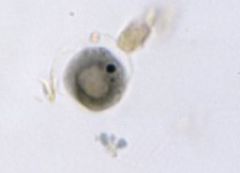
A. Entamoeba histolytica
B. Entamoeba coli C. Endolimax nana D. Iodamoeba buetschlii E. Blastocystis hominis |
Iodamoeba buetschlii cyst: Note the large endosome in the nucleus and the large glycogen vacuole.
|
|
|
Which of the following cause human disease?
A. Entamoeba Histolytica B. Entamoeba hartmanni C. Entamoeba gingivalis D. Iodamoeba butschilii E. Endolimax nana |
Entamoeba histolytica is the only intestinal amoeba to cause disease. It causes amoebic dysentary and can diseminate to cause abcesses (esp. liver). The rest are non-pathogenic. Entamoeba gingivalis looks exactly like E. histo but is non-pathogenic.
|
|

A. Entamoeba histolytica
B. Entamoeba coli C. Endolimax nana D. Iodamoeba buetschlii E. Blastocystis hominis |
Blastocystis hominis cyst
A member of the amoeba family. Some controversy that it may cause disease. Characterised by a large membrane bound central body which occupies 90% of the cell. |
|
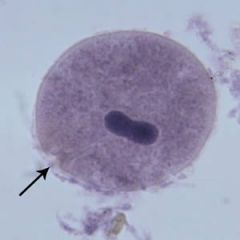
Pick the true statement
A. Crayfish are a reservoir for this organism B. This organism does not cause disease in humans C. This organism forms flask-shaped ulcers in the colon D. Pigs are a reservoir for this organism |
Balantidium coli
The only known ciliate to cause human disease. Note the large size, ciliated surface and prominent marconucli. Pigs are a reservoir. Makes shallow ulcers in the colon (flask-shaped = E. histolytica). |
|

What is the approximate size of this organism?
A. 2-4um B. 5-10um C. 15-20um D. 40+um |
D. This is Balantidium coli
The only known ciliate to cause human disease. Note the large size (40-200um), ciliated surface and prominent marconucli. Pigs are a reservoir. Makes shallow ulcers in the colon. |
|

A. Crytosporidium parvum
B. Isospora belli C. Microsporidium D. Cyclospora cayetanensis |
Cryptosporidium parvum
4-5um. Sits on brush border of SI (but does reproduce in enterocytes). Self-limited infection in normal individuals. Dangerous for immunosuppressed. Duodenal string test can be used to recover organisms. |
|

A. Crytosporidium parvum
B. Isospora belli C. Microsporidium D. Cyclospora cayetanensis |
Isospora belli Oval-shaped, intracellular.
Worse in the Immunosuppressed. The double nuclei, clearish form is secreted in stool. |
|

A. Crytosporidium parvum
B. Isospora belli C. Microsporidium D. Cyclospora cayetanensis |
Isospora belli
Worse in the Immunosuppressed. Unlike cryptosporidium, it is intracellular. The double nuclei, clearish form is secreted in stool |
|

A. Crytosporidium parvum
B. Isospora belli C. Microsporidium D. Cyclospora cayetanensis |
Microsporidium spp.
Note that this is very high power. The organism is 1 to 4um. Obligate intracellular pathogen seen primarily in patients with AIDS. Recently found to actually be a type of fungi. |
|

A. Crytosporidium parvum
B. Isospora belli C. Microsporidium D. Cyclospora cayetanensis |
Cyclospora cayetanensis
Diarrhea in India. Similar disease and reservoir to cryptosporidium. Larger than Isospora at ~12um. |
|

Pick the true statement
A. It is found in highest numbers in the cecum/colon B. Fish are a natural reservoir C. It is a non-pathogen D. The number of organisms does not correlate with severity of disease. |
D. This is a Giardia intestinalis cyst. While it is common in streams and water sources, mammals (many different types) and birds are the reservoir. Infection is common and causes diarrhea. Highest levels are found in the duodenum (2010 board question) however, the pathogenesis of the disease is not well understood and curiously, D is correct.
|
|

A. Giardia intestinalis
B. Chilomastrix misnilli C. Schistosoma haematobium D. Entamoeba coli |
B. This is Chilomastrix misnilli trophozoite. A non-pathogen that can be confused with giardiasis. Note the pointed end. Reside in the cecum/colon.
|
|

Pick the true statement
A. It is found in highest numbers in the duodenum B. Fish are a natural reservoir C. It is a non-pathogen D. It is endemic in underdeveloped rejoins of the world |
Chilomastrix misnilli trophozoite. A non-pathogen that can be confused with giardiasis. Note the pointed end. Reside in the cecum/colon.
|
|
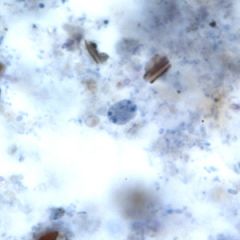
A. Isospora belli
B. Chilomastrix misnilli C. Cyclospora cayetanensis D. Enteromonas hominis |
D. This is Enteromonas hominis, a non-pathogenic organism. In binucleate forms, the nuclei are often at opposite polar ends of the cyst; in forms with four nuclei, they are often paired at opposite ends.
|
|
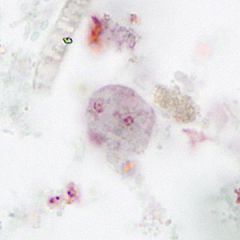
Pick the false statement about this organism
A. The cysts are transmitted via fecal-oral route B. This organism is a flagellate C. There is much debate whether this organism is a true pathogen. D. This organism replicates vis binary fission. |
A. This is Dientamoeba fragilis no cyst stage is identified however it is spread via fecal-oral route. Not an amoeba but a flagellate despite its name. Debate whether it causes disease. Note the broken up chromatin.
|
|
|
T/F for each of the following regarding Naegleria fowleri
1. It can be flagellated. 2. It is usually in its cyst form in tissue. 3. It is associated with fish tanks 4. It is an amoeba |
1. T -- it is a ameboflagellate.
2. F -- Unlike Acanthamoeba and balamuthia, Naegleria does not make cyst in tissue. 3. F -- Causes meningoencephalitis and is gotten from ponds and swimming pools. 4. T -- see #1 |
|
|
Which causes granulomatous encephalitis?
A. Taenia solium B. Taenia sagitus C. Toxoplasmosis gondii D. Naegleria fowleri E. Acathamoeba astronyxis |
E. Several acanthamoeba spp. have been associated with human disease. Acanthamoeba reach the brain via the bloodstream and cause granulomatous amebic encephalitis. It can also infect eyes (contact lenses) or bone.
|
|
|
T/F regarding each of the following statements
1. Acanthamoeba is associated with swimming in ponds 2. The diagnosis of Granulomatous amebic encephalitis is made by finding acanthamoeba cysts in the tissue. 3. Acanthamoeba is an ameboflagellate |
F -- Acanthamoeba is everywhere in the environment and is often gotten through the skin or through inhalation.
T -- Unlike N. fowleri, Acanthamoeba and balamuthia form characteristic cysts in the tissue. F -- Naegleria fowleri is an ameboflagellate, acanthamoeba is an amoeba. |
|
|
What amoeba can cause ocular kerititis?
|
Acanthamoeba. Presents as severe ocular pain and is associated with contact lens use. The cysts can be indentified using IF antibodies or with calcofluor white stain from corneal scrapings.
Balamuthia can also cause kerititis but is much more rare. |
|

This was found in the brain, what is it?
A. Naegleria fowleri B. Entamoeba histolytica C. Acanthamoeba spp. D. Toxocara gondii |
A. This is most likely Naegleria fowleri trophozoites since no cysts are seen however Acanthamoeba cannot be ruled out. Associated with swimming. Does not form cysts in tissue, unlike acanthamoeba and balamuthia. Often deadly.
|
|

This was found in the brain, what is it?
A. Naegleria fowleri B. Ascaris lumbricoides C. Acanthamoeba spp. D. Toxocara gondii |
Acanthamoeba spp.
Acanthamoeba and balamuthia can cause amebic encephalitis and can be found in the cyst from in the tissue. Ascaris eggs, while looking similar, are bigger and found in the stool. Toxocara cysts have a grainy look, without the prominent nucleoli |
|
|
Which of the following intestinal flagellates cause disease?
A. Giardia lamblia B. Chilomastix menili C. Enteromonas hominis D. Retortamonas |
Only Giardia
|
|
|
Where is Giardia most likely to be found?
A. Duodenum B. Jejunum C. Ileum D. Colon E. Stomach |
Duodenum
The can migrate to the gallbladder and biliary tract on occasion. |
|
|
Which cause disese (>1)?
A. Balantidium coli B. Chilomastix mesnilli C. Trichomonas hominis D. Enteromonas hominis E. Isospora belli |
A and E
Isospora causes diarrhea, worse in immunosuppressed. Trichomonas hominis, unlike T. vaginalis, does not cause disease. Balantidium causes shallow ulcers and diarrhea. |
|

What is the vector of this organism?
A. Sandfly B. Reduviid bug C. Mosquito D. Ixodes tick |
B. Reduvid bug. This is Trypanosoma Cruzi. Note the large kinetoplast vs. Trypanosoma brucei which has a smaller kinetoplast.
|
|

This is a tissue section. Which is not on the differential?
A. Trypanosoma cruzi B. Trypanosoma brucii C. Leishmania spp. D. Histoplasma capsulatum |
B. This is Trypanosoma cruzi however histoplasmosis capsulatum and Leishmaniasis can look very similar. T. Cruzi has an amastigotic form, unlike, T. brucii.
|
|

What is the associated protazoan parasite?
|
Trypanosoma cruzi.
This is unilateral edema of the upper and lower eyelid (Romana's sign) which is associated with early chaga's disease. Unilateral lymphadenopathy is also a common finding with early Chaga's. |
|
|
T/F regarding Chaga's disease.
1. Chronic infection can cause megacolon 2. It can be spread via breast milk. 3. It is often self-limiting. 4. EKG changes are common |
All are true. Congenital infection is a big problem and many of the deaths are young children.
|
|

Hepatosplenomegaly, no skin lesions.
A. Leishmania braziliensis B. Leishmania donovani C. Toxoplasma gondii D. Histoplasma capsulatum |
B. Leishmania donovani is the only cause of visceral leishmaniasis. All the others cause cutaneous or mucocutaneous (braziliensis) disease. Hepatosplenomegaly is common. Note the prominent perinuclear kinetoplast.
|
|
|
Match the vector with the disease.
1. Leishmania A. Reduviid bug 2. T. Cruzi B. Sandfly 3. T. brucii C. Tsetse fly |
Leishmania -- Sandfly
T. Cruzi -- Reduviid bug T. Brucii -- Tsetse fly |
|

T/F
1. Toxoplasma gondii is an obligate intracellular organism 2. Among healthy individuals, toxoplasmosis is benign. 3. AIDS patients are the primary concern for infection with toxoplasmosis |
1. T
2. F Neonates are an important population of "healthy" individuals that can have serious sequela, otherwise it is benign in the health. 3. F While AIDS patients are a concern, another, perhaps more pertinent concern are fetuses of pregnant individuals. |
|
|
What two types of malaria can remain dormant in the liver?
A. Plasmodium falciparum B. Plasmodium vivax C. Plasmodium ovale D. Plasmodium malaria |
B and C. Vivax and Ovale (the two with red dots). They can remain dormant and reinduce disease later in life.
|
|
|
Can you develop relapsing malarial disease from a blood transfusion?
|
No. The mosquito form of the organism is the only one that affects liver cells. Liver cells are where malaria (vivax and ovale) become dormant.
|
|
|
The absence of what blood group antigen confers resistance to Plasmodium Vivax?
|
Duffy A and B. This is why Vivax is not found in NorthWest africa. There is a high percentage of Duffy (-) individuals.
|
|

A. Plasmodium falciparum
B. Plasmodium vivax C. Plasmodium ovale D. Plasmodium malaria E. Babebia microti |
Babebia spp. (microti in N.America)(divergens in Europe)
These are the classic tetrads. |
|
|
What is the vector for babesiosis?
A. Mosquito B. Sand fly C. Ixodes tick D. Crayfish |
Ixodes tick (deer tick)
|
|
|
How long after visiting a country with endemic malaria can I donate blood?
A. Right away B. 6 months C. 1 year D. 3 years E. Never |
C. Visitors are deferred for one year after their return. People who used to live in such countries are deferred for 3 years. People diagnosed with malaria must wait 3 years also.
|
|
|
How long having malaria until I can donate blood?
A. Right away B. 6 months C. 1 year D. 3 years E. Never |
D. People who used to live in such countries are deferred for 3 years. People diagnosed with malaria must wait 3 years also. Visitors are deferred for one year after their return.
|
|

A. Plasmodium falciparum
B. Plasmodium vivax C. Plasmodium ovale D. Plasmodium malaria E. Babebia microti |
Ring-form trophozoites (rings) of Plasmodium falciparum are often thin and delicate, measuring on average 1/5 the diameter of the red blood cell.
|
|
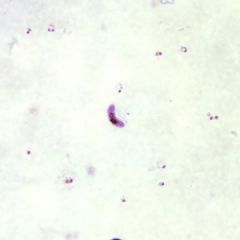
A. Plasmodium falciparum
B. Plasmodium vivax C. Plasmodium ovale D. Plasmodium malaria E. Babebia microti |
Plasmodium falciparum gametocyte
This and the ring forms are most often seen since the other forms are present when the RBC's are attached to capillaries. |
|

A. Plasmodium falciparum
B. Plasmodium vivax C. Plasmodium ovale D. Plasmodium malaria E. Babebia microti |
Plasmodium malariae. This is the band form. Both malariae and falciparum lack the schuffner's dots.
|
|

A. Plasmodium falciparum
B. Plasmodium vivax C. Plasmodium ovale D. Plasmodium malaria E. Babebia microti |
Plasmodium ovale trophozoite.
Note the tattered edge and presence of Schuffner's dots. |
|

A. Plasmodium falciparum
B. Plasmodium vivax C. Plasmodium ovale D. Plasmodium malaria E. Babebia microti |
Plasmodium Ovale
Schizonts of P. ovale can be similar to P. vivax, although tend to be smaller and contain fewer merozoites (4-16, on average 8). Note the Schuffner's dots. |
|

A. Plasmodium falciparum
B. Plasmodium vivax C. Plasmodium ovale D. Plasmodium malaria E. Babebia microti |
Plasmodium vivax
Note the shuffner's dots and enlarged size of the infected RBC. |
|

A. Plasmodium falciparum
B. Plasmodium vivax C. Plasmodium ovale D. Plasmodium malaria E. Babebia microti |
Plasmodium vivax
While the schuffner's dots aren't prominent, note the numerous gametocytes (12-24) which is typical of P. vivax. |
|
|
Which organism is associated with nephrotic syndrome?
A. Plasmodium falciparum B. Plasmodium vivax C. Plasmodium ovale D. Plasmodium malaria |
D. Plasmodium malaria
|
|
|
Which organism is associated with CNS involvement?
A. Plasmodium falciparum B. Plasmodium vivax C. Plasmodium ovale D. Plasmodium malaria |
A. Plasmodium falciparum
|
|
|
Which organism preferentially infects "older" erythrocytes?
A. Plasmodium falciparum B. Plasmodium vivax C. Plasmodium ovale D. Plasmodium malaria |
D. Plasmodium malaria
P. falicparum infects any RBCs. Vivax and Ovale infect younger RBCs. |
|

What type of organism is this?
A. Fungus B. Algae C. Bacteria D. Parasite egg E. Protozoa |
B. This is Protothecia Wickermanii. It is a rare cause of infection in immunocompromised.
|

